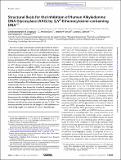Structural basis for the inhibition of human alkyladenine DNA by 3,N4-ethenocytosine containing DNA
Author(s)
Lingaraju, Gondichatnahalli M.; Davis, Christopher A.; Setser, Jeremy Wayne; Samson, Leona D; Drennan, Catherine L
DownloadMain article (1.950Mb)
PUBLISHER_POLICY
Publisher Policy
Article is made available in accordance with the publisher's policy and may be subject to US copyright law. Please refer to the publisher's site for terms of use.
Terms of use
Metadata
Show full item recordAbstract
Reactive oxygen and nitrogen species, generated by neutrophils and macrophages in chronically inflamed tissues, readily damage DNA, producing a variety of potentially genotoxic etheno base lesions; such inflammation-related DNA damage is now known to contribute to carcinogenesis. Although the human alkyladenine DNA glycosylase (AAG) can specifically bind DNA containing either 1,N6-ethenoadenine (ϵA) lesions or 3,N4-ethenocytosine (ϵC) lesions, it can only excise ϵA lesions. AAG binds very tightly to DNA containing ϵC lesions, forming an abortive protein-DNA complex; such binding not only shields ϵC from repair by other enzymes but also inhibits AAG from acting on other DNA lesions. To understand the structural basis for inhibition, we have characterized the binding of AAG to DNA containing ϵC lesions and have solved a crystal structure of AAG bound to a DNA duplex containing the ϵC lesion. This study provides the first structure of a DNA glycosylase in complex with an inhibitory base lesion that is induced endogenously and that is also induced upon exposure to environmental agents such as vinyl chloride. We identify the primary cause of inhibition as a failure to activate the nucleotide base as an efficient leaving group and demonstrate that the higher binding affinity of AAG for ϵC versus ϵA is achieved through formation of an additional hydrogen bond between Asn-169 in the active site pocket and the O2 of ϵC. This structure provides the basis for the design of AAG inhibitors currently being sought as an adjuvant for cancer chemotherapy.
Date issued
2011-04Department
Massachusetts Institute of Technology. Center for Environmental Health Sciences; Massachusetts Institute of Technology. Department of Biological Engineering; Massachusetts Institute of Technology. Department of Biology; Massachusetts Institute of Technology. Department of Chemistry; Koch Institute for Integrative Cancer Research at MITJournal
Journal of Biological Chemistry
Publisher
American Society for Biochemistry and Molecular Biology, Inc.
Citation
Lingaraju, Gondichatnahalli M. et al. “Structural Basis for the Inhibition of Human Alkyladenine DNA Glycosylase (AAG) by 3,N4-Ethenocytosine-containing DNA.” Journal of Biological Chemistry 286.15 (2011) : 13205 -13213. © 2011 by American Society for Biochemistry and Molecular Biology.
Version: Final published version
ISSN
0021-9258
1083-351X